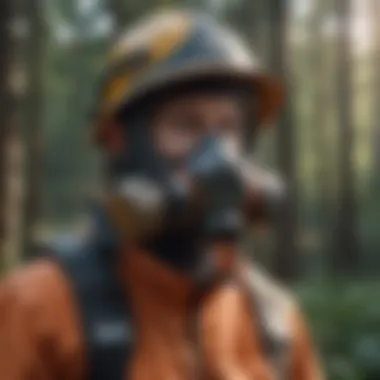Comprehensive Guide to Proper Asbestos Roof Removal Process for Safety and Compliance


Asbestos roofs, once a popular choice in construction due to their durability and fire-resistant properties, now pose a significant health risk requiring careful removal processes. This comprehensive guide delves into every step of the asbestos roof removal process, emphasizing safety measures, legal requirements, disposal methods, and potential health hazards. Understanding these crucial aspects is paramount to ensure the safe handling of asbestos roofs and the protection of both individuals and the environment.
Safety Measures and Equipment
When embarking on asbestos roof removal, stringent safety measures must be in place to mitigate the risk of exposure to harmful asbestos fibers. Workers involved in the removal process should be equipped with personal protective equipment (PPE) such as respirators, coveralls, gloves, and eye protection. Additionally, establishing an isolated work area with barriers to prevent the spread of asbestos fibers is essential to protect both workers and nearby individuals.
Legal Requirements and Regulations
Adherence to legal requirements and regulations surrounding asbestos removal is paramount to avoid fines and ensure public safety. Regulations dictate proper disposal methods, notification of authorities before commencing removal, and the qualifications required for professionals undertaking asbestos removal. Failing to comply with these regulations can lead to severe penalties and endanger the health of those in the vicinity.
Disposal Methods and Waste Management
Proper disposal of asbestos-containing materials is crucial to prevent further exposure and contamination. Asbestos waste must be sealed in double bags or containers to prevent fiber release and transported to licensed disposal sites. Specialized waste management companies and facilities are equipped to handle and dispose of asbestos waste safely and in accordance with regulations to minimize environmental impact.
Health Risks Associated with Asbestos Exposure
Exposure to asbestos fibers can lead to serious health risks, including lung diseases such as asbestosis and mesothelioma. Understanding the potential health hazards associated with asbestos exposure underscores the importance of following proper removal procedures to safeguard the well-being of individuals involved in the removal process and those in the surrounding environment.
Understanding the Importance of Safe Asbestos Roof Removal
In the comprehensive exploration of the asbestos roof removal process, it becomes evident that prioritizing safety measures, adhering to legal regulations, implementing proper disposal methods, and recognizing the health risks associated with asbestos exposure are fundamental aspects of ensuring the effective and secure removal of asbestos roofs. This detailed guide equips individuals with the knowledge and understanding necessary to execute asbestos roof removal procedures meticulously and responsibly.
Introduction to Asbestos Roofing
In delving into the world of asbestos roofing, it is essential to comprehend the crucial role it plays in the construction industry. Asbestos, known for its fire-resistant and insulating properties, has been a preferred roofing material for decades. Despite its effectiveness, the presence of asbestos poses significant health risks, leading to the need for a thorough understanding of its implications in building structures. This section will explore the different aspects of asbestos roofing, shedding light on its types, applications, and the importance of proper handling.
Understanding Asbestos


Definition of Asbestos
Defining asbestos is fundamental to grasp its significance in construction. Asbestos refers to a group of naturally occurring minerals known for their heat resistance and durability. Its fibrous nature makes it a versatile material for various industrial applications, including roofing. This section will delve into the distinct characteristics of asbestos and why it has been a favored choice in the roofing industry, despite its associated risks.
History of Asbestos Use
The history of asbestos usage traces back centuries, with early civilizations recognizing its valuable properties. Over time, asbestos gained popularity for its strength and affordability, leading to widespread incorporation in building materials. Understanding the historical context of asbestos use is vital to contextualize its prevalence in modern structures and the challenges it presents in terms of removal and disposal.
Asbestos Roofing Materials
Types of Asbestos Roofing
Exploring the various types of asbestos roofing materials is crucial for identifying potential hazards and conducting safe removal processes. Different types of asbestos, such as chrysotile, amosite, and crocidolite, have been utilized in roofing applications, each with its unique properties and levels of risk. This section will discuss the characteristics of these asbestos types and their implications for roofing projects, highlighting the importance of proper identification and handling.
Common Applications
The common applications of asbestos roofing encompass a wide range of structures, from residential homes to commercial buildings. Asbestos roofing materials have been favored for their durability and resistance to environmental factors. This part of the article will delve into the prevalent uses of asbestos in roofing, emphasizing the need for caution and adherence to safety protocols during roof removal processes.
Health Risks Associated with Asbestos
The section on Health Risks Associated with Asbestos delves deep into the potential dangers posed by exposure to asbestos materials. This topic is crucial in the context of asbestos roof removal as it highlights the inherent risks involved in handling and disposing of asbestos-containing elements. By understanding the health risks associated with asbestos, individuals can take the necessary precautions to safeguard themselves and the environment.
Asbestos Exposure
Health Concerns
When discussing the Health Concerns related to asbestos exposure, we shed light on the various illnesses and conditions that can arise from coming into contact with asbestos fibers. These health concerns encompass a range of respiratory issues, including asbestosis and mesothelioma, that can have debilitating effects on individuals exposed to asbestos over time. Understanding these specific health concerns is paramount in emphasizing the importance of proper safety measures during asbestos roof removal processes.


Symptoms of Asbestos Exposure
The Symptoms of Asbestos Exposure section outlines the signs and indicators that may manifest in individuals who have been exposed to asbestos. These symptoms could include persistent coughing, chest pain, and difficulty breathing, among others. Recognizing these symptoms is crucial for early detection and prompt medical intervention to mitigate the potentially severe health consequences of asbestos exposure.
Legal Regulations on Asbestos
Exploring the Legal Regulations on Asbestos provides insight into the established guidelines and laws that govern the handling and disposal of asbestos materials. By delving into the OSHA Guidelines, we underscore the importance of adhering to strict safety protocols to minimize the health risks associated with asbestos exposure. Understanding the nuances of these regulations is fundamental in ensuring compliance and promoting safe practices within the asbestos removal industry.
OSHA Guidelines
The OSHA Guidelines set forth by regulatory bodies offer detailed instructions on how to safely work with asbestos-containing materials. These guidelines encompass protocols for the use of personal protective equipment, containment procedures, and proper disposal methods to limit exposure and prevent harm. Adhering to OSHA Guidelines is essential for upholding occupational health and safety standards in asbestos removal procedures.
Disposal Laws
The section on Disposal Laws highlights the legal requirements for disposing of asbestos waste in a manner that minimizes environmental impact and public health risks. By elucidating the specific regulations surrounding asbestos disposal, individuals and companies involved in the asbestos removal process can ensure compliance with local and federal guidelines. Understanding these disposal laws is critical in promoting responsible environmental stewardship and preventing further spread of asbestos contamination.
Asbestos Roof Removal Process
As we delve into the intricate process of asbestos roof removal, it becomes evident that this topic holds paramount importance within the scope of this comprehensive guide. Understanding the nuances of asbestos roof removal is crucial for ensuring the safety of individuals and the environment. By dissecting each aspect of the removal process, we are not only highlighting the key steps involved but also shedding light on the potential risks associated with mishandling asbestos. Through a detailed exploration of safety measures, legal requirements, disposal methods, and health risks, readers are equipped with the knowledge needed to navigate the complexities of asbestos roof removal with precision and care.
Safety Precautions
Within the realm of safety precautions, the efficacy of protective gear emerges as a cornerstone in safeguarding individuals involved in asbestos roof removal. Protective gear serves as a vital barrier between workers and the hazardous asbestos fibers, thereby mitigating the risk of exposure. The incorporation of specialized suits, masks, gloves, and goggles ensures that each worker is adequately shielded from potential harm. While the protective gear offers a robust defense mechanism, it is imperative to acknowledge the meticulous care required in its utilization to maintain its integrity and effectiveness throughout the removal process.
When it comes to containment procedures, meticulous attention to detail is fundamental in preventing the spread of asbestos fibers beyond the removal site. Containment procedures entail the establishment of controlled zones using barriers and negative air pressure systems to contain any released fibers. This strategic containment approach not only minimizes the risk of contamination in surrounding areas but also underscores a commitment to comprehensive safety practices. By implementing stringent containment protocols, asbestos removal teams uphold the highest standards of safety and environmental protection.
Removal Techniques


The wet removal method emerges as a prominent technique in asbestos roof removal, characterized by its effectiveness in minimizing fiber release during the removal process. By saturating the asbestos-containing material with a water-based solution, this method encapsulates the fibers, reducing the likelihood of airborne dispersion. The wet removal method's ability to create a controlled and damp environment ensures a safer working condition for removal teams, promoting a more secure removal process overall.
In contrast, the dry removal method relies on careful dismantling and extraction of asbestos materials without the use of liquid agents. This method prioritizes strategic handling procedures to minimize fiber disturbance and potential release into the air. While the dry removal method demands meticulous precision and expertise from removal teams, its tailored approach offers a viable alternative for scenarios where wet removal may not be feasible or preferred.
Disposal of Asbestos
Licensed disposal sites play a pivotal role in the final stages of the asbestos removal process, offering designated facilities for the safe containment and management of hazardous waste. These specialized sites adhere to strict regulations stipulated by authorities to ensure proper disposal practices that mitigate environmental impact. By entrusting asbestos waste to licensed disposal sites, removal teams uphold environmental responsibility and ethical disposal standards, contributing to the larger ecosystem of environmental conservation and sustainability.
When it comes to packaging requirements, the meticulous adherence to specified guidelines is paramount in facilitating the safe transport and disposal of asbestos waste. Packaging requirements dictate the proper sealing, labeling, and securing of asbestos-containing materials to prevent fiber release during transit and storage. Compliance with packaging protocols not only ensures regulatory alignment but also underscores a dedication to best practices in waste management. By prioritizing precision in packaging, removal teams uphold the integrity of the removal process from site to disposal site.
Post-Removal Considerations:
In the aftermath of asbestos roof removal, Post-Removal Considerations play a pivotal role in ensuring a safe and healthy environment. These considerations are crucial because they involve the necessary steps to confirm that the removal process was effective and no asbestos fibers remain lingering in the air or on surfaces. Proper Post-Removal Considerations also involve compliance with regulatory standards and guidelines, emphasizing the importance of thorough inspections and testing to validate the removal's effectiveness. By meticulously addressing Post-Removal Considerations, the risk of asbestos recontamination is significantly reduced, safeguarding both individuals and the environment.
Clearance Testing:
Air Monitoring:
Air Monitoring is a critical component of the clearance testing process post-asbestos removal. This method involves sampling the air within and around the removal site to detect any traces of airborne asbestos fibers. The key characteristic of Air Monitoring lies in its ability to provide real-time data on asbestos levels, ensuring that the environment is safe for reoccupation. Air Monitoring is a popular choice due to its accuracy in measuring asbestos concentrations, thereby guiding decisions on the clearance of the area for reentry. While Air Monitoring offers precise results, its main disadvantage is the need for specialized equipment and trained professionals to conduct the test effectively.
Final Inspection:
Following the completion of asbestos removal, a Final Inspection serves as the conclusive step to validate the site's safety and readiness for unrestricted access. The key characteristic of Final Inspection is its comprehensive nature, involving meticulous checks to confirm that all asbestos-containing materials have been successfully removed and disposed of as per regulations. This inspection ensures that the area is clean and free from any residual asbestos contamination, providing assurance to occupants and regulatory bodies. While Final Inspection is essential for certifying a safe environment, its main disadvantage lies in the potential delays it may cause in reoccupying the space, especially if issues are identified that require further remediation.
Maintenance of Asbestos-Free Environment:
Preventive Measures:
Maintaining an asbestos-free environment necessitates the implementation of robust Preventive Measures to minimize the risk of future asbestos exposure. These measures include regular inspections to identify any potential sources of asbestos and prompt remediation if deemed necessary. The key characteristic of Preventive Measures is their proactive approach in preventing asbestos-related hazards before they escalate. The unique feature of Preventive Measures is their ability to protect occupants from unknowingly encountering asbestos-containing materials, reducing the likelihood of exposure-related illnesses. While Preventive Measures are beneficial in safeguarding individuals, their main disadvantage may lie in the costs associated with ongoing monitoring and maintenance efforts.
Regular Inspections:
Regular Inspections are integral to upholding an asbestos-free environment by conducting periodic assessments to detect any signs of asbestos presence or degradation of asbestos abatement measures. The key characteristic of Regular Inspections is their systematic approach in identifying changes that may pose risks of asbestos exposure. Regular inspections are a popular choice for ensuring continuous compliance with asbestos regulations and standards, thereby maintaining a safe environment for all occupants. The unique feature of Regular Inspections lies in their role in early detection of potential asbestos hazards, allowing timely intervention to prevent safety breaches. While Regular Inspections are advantageous in preserving a safe environment, their main disadvantage may be the resource-intensive nature of conducting frequent assessments.



